- Clone
- 15E2 (See other available formats)
- Regulatory Status
- RUO
- Workshop
- HCDM listed
- Other Names
- CLECSF12, beta-glucan receptor (BGR, betaGR), CD369
- Isotype
- Mouse IgG2a, κ
- Ave. Rating
- Submit a Review
- Product Citations
- publications
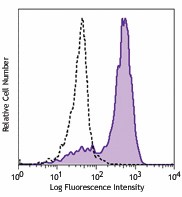
-

Human peripheral blood monocytes were stained purified anti-human CD369 (Dectin-1/CLEC7A, clone 15E2) or purified mouse IgG2a, κ isotype control, followed by anti-mouse IgG PE.
| Cat # | Size | Price | Quantity Check Availability | Save | ||
|---|---|---|---|---|---|---|
| 355402 | 100 µg | 165€ | ||||
CD369 (Dectin-1), also known as CLEC7A and beta-glucan receptor (BGR), is a 33 kD type II transmembrane C-type lectin. It consists of a C-terminal stalk with a carbohydrate recognition domain (CRD) in the extracellular domain, a transmembrane segment, and a short N-terminal ITAM containing a cytoplasmic tail. CLEC7A is predominantly expressed on dendritic cells. Subsequent work has shown expression on B cells, monocytes, eosinophils, mast cells, macrophages, endothelial cells, and low expression on some subsets of T cells. CLEC7A lacks residues involved in calcium ligation that mediates carbohydrate-binding by classical C-type lectins. CLEC7A functions as a receptor to mediate innate immunity to fungal pathogens by selectively binding beta-glucan polymers, a major component of yeast and mycobacterial cell walls.
Product DetailsProduct Details
- Verified Reactivity
- Human
- Antibody Type
- Monoclonal
- Host Species
- Mouse
- Immunogen
- Ectodomain with C-term hFc fusion, RIBLS.
- Formulation
- Phosphate-buffered solution, pH 7.2, containing 0.09% sodium azide.
- Preparation
- The antibody was purified by affinity chromatography.
- Concentration
- 0.5 mg/ml
- Storage & Handling
- The antibody solution should be stored undiluted between 2°C and 8°C.
- Application
-
FC - Quality tested
IHC-F - Reported in the literature, not verified in house - Recommended Usage
-
Each lot of this antibody is quality control tested by immunofluorescent staining with flow cytometric analysis. For flow cytometric staining, the suggested use of this reagent is ≤1.0 µg per million cells in 100 µl volume. It is recommended that the reagent be titrated for optimal performance for each application.
- Application Notes
-
The epitope of clone 15E2 is LWEDGSTFSSN. Clone 15E2 can recognize the epitope in the presence of Curdlan and Laminarin (CLEC7A ligands). Additional reported applications (for the relevant formats) include: immunohistochemical staining.1
- Application References
-
- Ni L, et al. 2010. J. Immunol. 185:3504. (IHC)
- Product Citations
-
- RRID
-
AB_2561530 (BioLegend Cat. No. 355402)
Antigen Details
- Structure
- Type II transmemberane C-type lectin, one carbohydrate recognition domain, ITAM containing cytoplasmic tail
- Distribution
-
B cells, low level of some subsets of T cells, monocytes, dendritic cells, macrophages and endothelial cells
- Function
- Mediates innate immunity to fungal pathogens
- Interaction
- TLR2, CD37
- Ligand/Receptor
- Beta-glucan
- Cell Type
- B cells, Dendritic cells, Endothelial cells, Macrophages, Monocytes, T cells
- Biology Area
- Cell Biology, Immunology, Innate Immunity, Neuroscience, Neuroscience Cell Markers
- Molecular Family
- CD Molecules
- Antigen References
-
1. Goodridge HS, et al. 2011. Nature 472:471.
2. Saijo S, et al. 2007. Nat. Immunol. 8:39.
3. Brown GD. 2006. Nat. Rev. Immunol. 6:33.
4. Willment JA, et al. 2001. J. Biol. Chem. 276:43818.
5. Yokota K, et al. 2001. Gene 272:51. - Gene ID
- 64581 View all products for this Gene ID
- UniProt
- View information about CD369 on UniProt.org
Related Pages & Pathways
Pages
Related FAQs
Other Formats
View All CD369 Reagents Request Custom Conjugation| Description | Clone | Applications |
|---|---|---|
| Purified anti-human CD369 (Dectin-1/CLEC7A) | 15E2 | FC,IHC-F |
| PE anti-human CD369 (Dectin-1/CLEC7A) | 15E2 | FC |
| APC anti-human CD369 (Dectin-1/CLEC7A) | 15E2 | FC |
| PerCP/Cyanine5.5 anti-human CD369 (Dectin-1/CLEC7A) | 15E2 | FC |
Customers Also Purchased
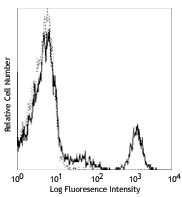

Compare Data Across All Formats
This data display is provided for general comparisons between formats.
Your actual data may vary due to variations in samples, target cells, instruments and their settings, staining conditions, and other factors.
If you need assistance with selecting the best format contact our expert technical support team.
-
Purified anti-human CD369 (Dectin-1/CLEC7A)
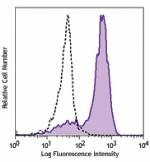
Human peripheral blood monocytes were stained purified anti-... -
PE anti-human CD369 (Dectin-1/CLEC7A)
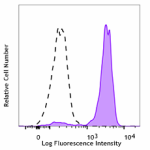
Human peripheral blood monocytes were stained with anti-huma... -
APC anti-human CD369 (Dectin-1/CLEC7A)
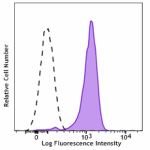
Human peripheral blood monocytes were stained with anti-huma... -
PerCP/Cyanine5.5 anti-human CD369 (Dectin-1/CLEC7A)
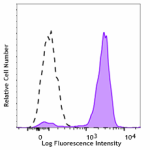
Human peripheral blood monocytes were stained with anti-huma...

 Login / Register
Login / Register 





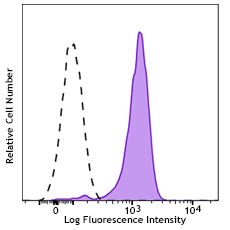
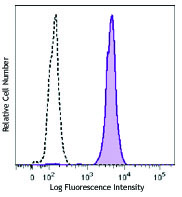



Follow Us